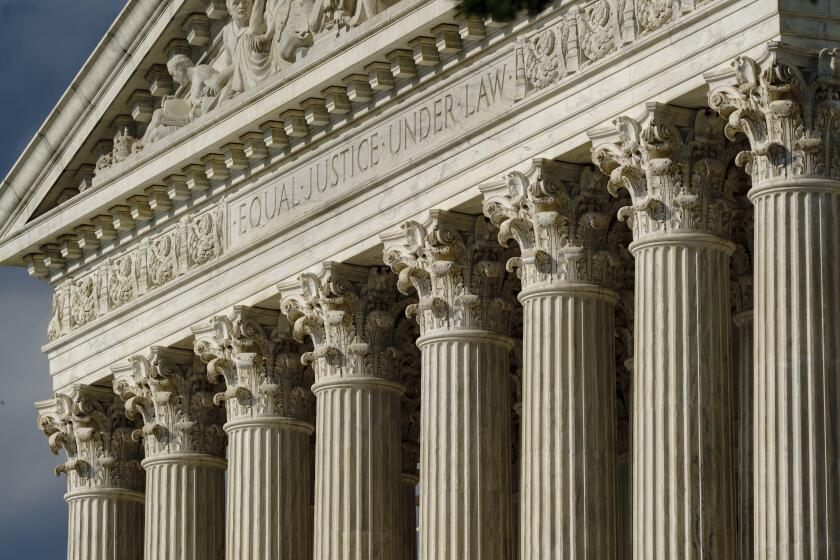Roe’s Author Found Himself a Bystander in ’92 Abortion Fight
- Share via
WASHINGTON — In the spring of 1992, Supreme Court Justice Harry A. Blackmun, the author of the Roe vs. Wade opinion two decades earlier, found himself a bystander as the justices debated whether to overturn the right to abortion.
The 83-year-old justice knew the abortion right was in danger, but he did not learn the story of its unexpected rescue until it was all over, according to papers of the late justice released Thursday by the Library of Congress.
“I’m not so sure that I can tell you how it came about,” Blackmun confided to a clerk afterward, adding that he was not involved in the intense battle over abortion within the court.
“I think they probably kept it to themselves,” he said of his colleagues.
The fight in the early 1990s over the fate of Roe vs. Wade was one of the most dramatic in the recent history of the court, yet Blackmun’s papers add little to what already is known -- that a surprise defection by Justice Anthony M. Kennedy helped preserve the right to abortion.
Presidents Reagan and George H.W. Bush, having pledged to protect the right to life, added five appointees to the Supreme Court between 1981 and 1991.
The new justices joined the two original dissenters from the Roe ruling: Byron R. White and William H. Rehnquist, who by 1992 was the chief justice.
The abortion right looked to be doomed, or so Blackmun thought. “A chill wind blows,” he intoned in a dissent after the majority had upheld a Missouri anti-abortion law.
In late April 1992, the high court took up a Pennsylvania case that challenged a series of new abortion regulations, including a requirement that pregnant women consult their spouses before obtaining an abortion. Separately, Louisiana and Utah had enacted laws that would forbid nearly all abortions.
When the justices met in a closed-door conference, all but Blackmun agreed to uphold most or all of the Pennsylvania regulations. But the surprise came when the majority explained why.
Rehnquist began work on an opinion that said women did not have a true right to choose abortion. States were free to limit this right to protect potential human life, he said.
This approach had been suggested by the first Bush administration’s solicitor general, Kenneth W. Starr. White and Justices Antonin Scalia and Clarence Thomas agreed. They thought the Roe decision was wrong and should be overturned at once.
Justices Sandra Day O’Connor and David H. Souter were not prepared to go that far, however. They began work on a separate, concurring opinion that would uphold “the central holding of Roe,” which gave women a right to choose abortion without “undue” interference from the government.
To their surprise, Kennedy said he agreed with their approach. Although personally and morally opposed to abortion, Kennedy believed that the Constitution’s protection for liberty left this choice with individual women.
Kennedy’s defection proved to be momentous. Suddenly, the majority on the most disputed question of constitutional law had shifted.
Justice John Paul Stevens, a strong supporter of the abortion right, learned of the newly formed “troika,” as the clerks called the O’Connor-Souter-Kennedy alliance. Stevens agreed to sign on to most of their opinion.
Blackmun was nearly the last to learn. On May 24, Kennedy sent him a handwritten note saying he had some “welcome news” for him. A few weeks before, Kennedy and Blackmun had talked privately, and the older justice had shown him letters from women who spoke of how the right to choose abortion had been important in their lives.
The two justices shared an inside joke. They described themselves as “No. 3s.” Blackmun was President Nixon’s third choice to fill a Supreme Court vacancy in 1970 after the Senate rejected two Southern conservatives: Judges Clement F. Haynsworth Jr. and G. Harrold Carswell.
Similarly, Kennedy was Reagan’s third choice to fill a vacancy in 1987, after the Senate voted down Judge Robert H. Bork and after Judge Douglas K. Ginsburg, Reagan’s second choice, withdrew a week after being nominated.
By early June 1992, when Blackmun agreed to join with the “troika,” the court had a five-member majority to affirm the right to abortion, not overturn it. Rehnquist, who had expected to speak for the majority, found himself writing a four-person dissent.
That same spring, the Blackmun papers reveal, Kennedy also shifted sides in a key school prayer case. The court’s conservative wing had pressed to relax the ban on school-sponsored prayers and invocations.
Kennedy thought the court had gone too far in barring Christmas displays and other religious symbols in government buildings. At first, he voted to uphold a graduation-day invocation. But when assigned to write the opinion, he changed his mind and concluded that the court must continue to bar school-sponsored prayers and invocations. While students may pray on their own at school, principals and teachers should not espouse religious messages in public schools, he wrote for the 5-4 majority.
Blackmun’s papers, like those of Justice Thurgood Marshall, contain surprisingly little in the justice’s own words. Most of the boxes are filled with draft opinions that were printed and circulated around the court. They also include legal memos from law clerks to the justice. Blackmun also filled boxes with letters from his friends and enemies.
More to Read
Get the L.A. Times Politics newsletter
Deeply reported insights into legislation, politics and policy from Sacramento, Washington and beyond. In your inbox twice per week.
You may occasionally receive promotional content from the Los Angeles Times.











